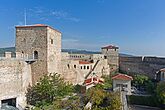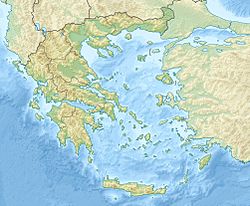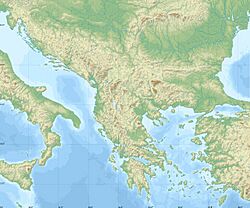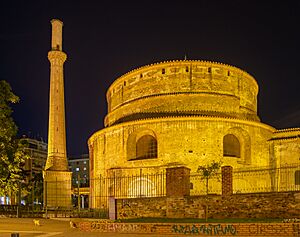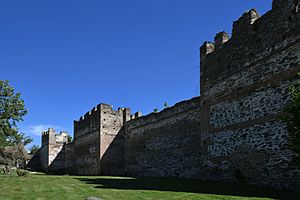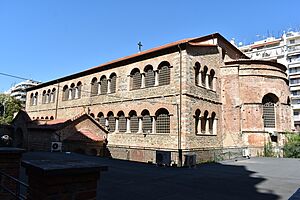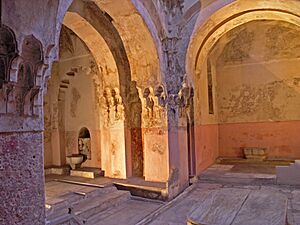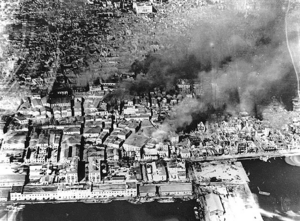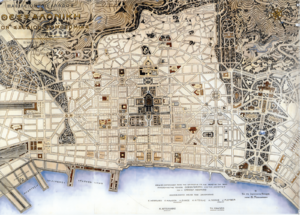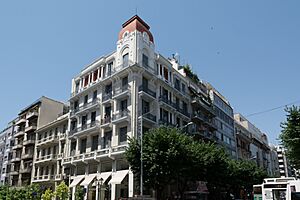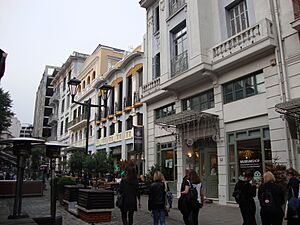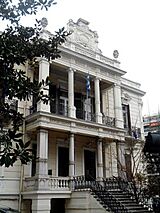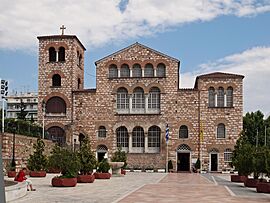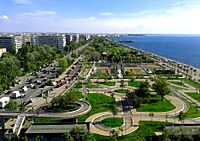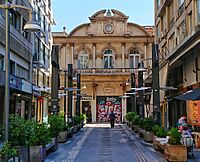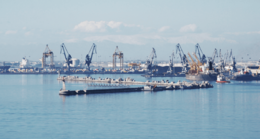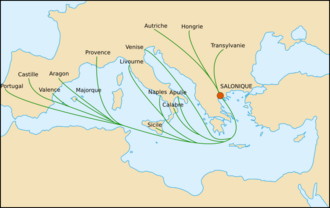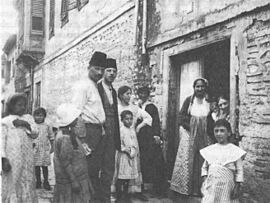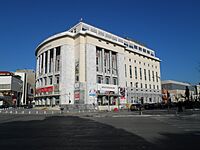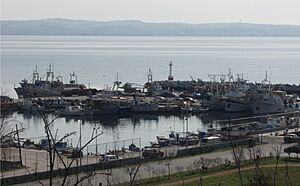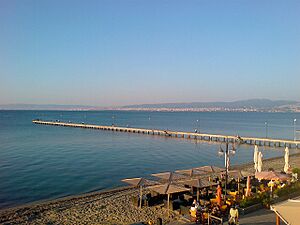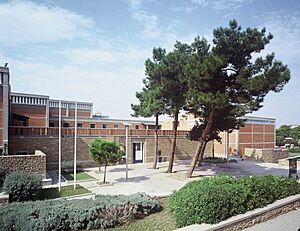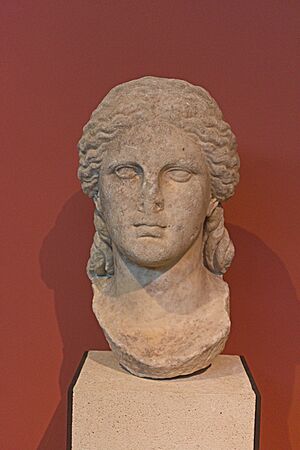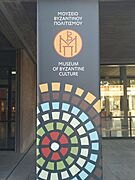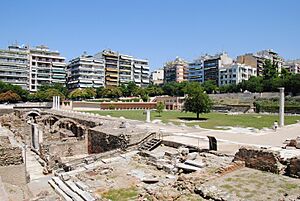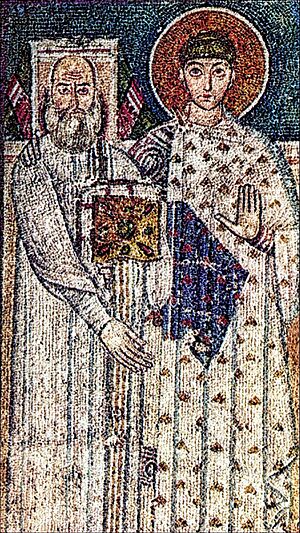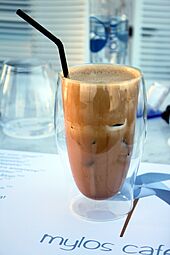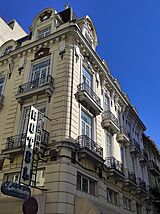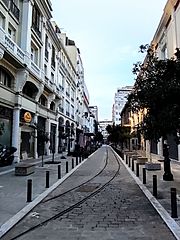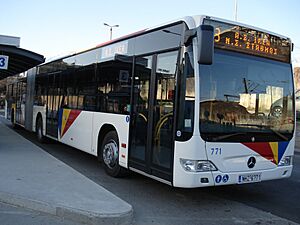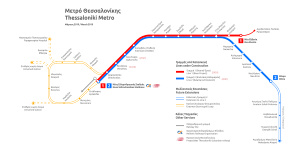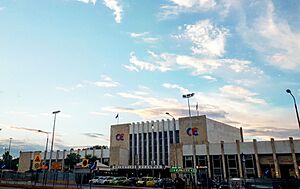Thessaloniki facts for kids
Quick facts for kids
Thessaloniki
Θεσσαλονίκη
Saloniki
|
|||||
|---|---|---|---|---|---|
|
Panoramic view of Thessaloniki's waterfront and the Thermaic Gulf
White Tower of Thessaloniki
Heptapyrgion
Arch of Galerius
Church of Saint Demetrius
Aristotle Square
|
|||||
|
|||||
| Nickname(s):
The Nymph of the Thermaic Gulf
|
|||||
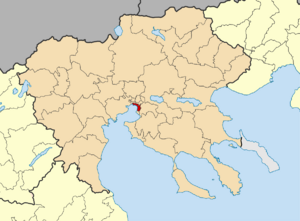
Location of the Municipality of Thessaloniki within Central Macedonia.
|
|||||
| Country | |||||
| Geographic region | |||||
| Administrative region | Central Macedonia | ||||
| Regional unit | Thessaloniki | ||||
| Founded | 315 BC (2340 years ago) | ||||
| Incorporated | October 1912 (112 years ago) | ||||
| Municipalities | 7 | ||||
| Government | |||||
| • Type | Mayor–council government | ||||
| Area | |||||
| • Municipality | 19.307 km2 (7.454 sq mi) | ||||
| • Urban | 111.703 km2 (43.129 sq mi) | ||||
| • Metro | 1,285.61 km2 (496.38 sq mi) | ||||
| Highest elevation | 250 m (820 ft) | ||||
| Lowest elevation | 0 m (0 ft) | ||||
| Population
(2021)
|
|||||
| • Municipality | 319,045 | ||||
| • Rank | 2nd urban, 2nd metro in Greece | ||||
| • Urban | 802,572 | ||||
| • Urban density | 7,184.87/km2 (18,608.74/sq mi) | ||||
| • Metro | 1,006,112 | ||||
| • Metro density | 782.595/km2 (2,026.912/sq mi) | ||||
| Demonym(s) | Thessalonian, Thessalonican | ||||
| Time zone | UTC+2 (EET) | ||||
| • Summer (DST) | UTC+3 (EEST) | ||||
| Postal codes |
53xxx, 54xxx, 55xxx, 56xxx
|
||||
| Area code | 2310 | ||||
| Vehicle registration | NA to NX | ||||
| Patron saint | Saint Demetrius (26 October) | ||||
| Gross regional domestic product (PPP 2015) | €18.77 billion ($Lua error in Module:Math at line 586: attempt to call field '?' (a nil value). billion) | ||||
| • Per capita | €16,900 | ||||
| Website | www.thessaloniki.gr | ||||
Thessaloniki (/ˌθɛsələˈniːki/; Greek: Θεσσαλονίκη [θesaloˈnici]), also known as Saloniki, is the second-largest city in Greece. It has over one million people in its wider area. Thessaloniki is the capital of the Macedonia region and Central Macedonia. It is also called "the co-capital" in Greek, because it was once a very important city in the Byzantine Empire, like Constantinople.
The city is located on the Thermaic Gulf, which is part of the Aegean Sea. Thessaloniki is Greece's second most important center for business, industry, and trade. It is also a major transport hub for Greece and southeastern Europe, thanks to its port. Thessaloniki is famous for its many festivals and lively cultural scene. Big events like the Thessaloniki International Fair and the Thessaloniki International Film Festival happen every year. In 2014, Thessaloniki was the European Youth Capital. Its main university, Aristotle University, is the largest in Greece and the Balkans.
Thessaloniki was founded in 315 BC by Cassander of Macedon. He named it after his wife, Thessalonike, who was the daughter of Philip II of Macedon and sister of Alexander the Great. It became a very important city during the Roman and Byzantine times. The Ottoman Empire took control of it in 1430. For nearly 500 years, it was a busy port city where churches, mosques, and synagogues existed side by side. From the 1500s to the 1900s, it was the only city in Europe where most people were Jewish. Greece took control of Thessaloniki in 1912. The city has many old buildings from Roman, Byzantine, and Ottoman times. Many of its early Christian and Byzantine monuments are now World Heritage Sites.
In 2013, National Geographic Magazine named Thessaloniki one of the best places to visit in the world. In 2014, Financial Times magazine said Thessaloniki was the best mid-sized European city for its people and lifestyle.
Contents
Understanding the City's Name

The city's original name was Thessaloníkē. It was named after Princess Thessalonike of Macedon, who was the half-sister of Alexander the Great. Her name means "Thessalian victory." This name honored a Macedonian victory in a battle around 353/352 BC.
Over time, the name changed in different languages. For example, in Greek, it became Saloníki. This shorter name was also used in other languages like Turkish (Selânik) and Italian (Salonicco).
When Thessaloniki became part of Greece in 1912, its official name went back to Thessaloniki.
A Look at Thessaloniki's Past
From Ancient Times to the Roman Empire
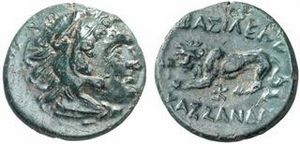
The city was founded around 315 BC by Cassander, the King of Macedon. He built it near an old town called Therma and 26 other villages. He named it after his wife, Thessalonike of Macedon, who was Alexander the Great's half-sister. Under the Macedonian kingdom, Thessaloniki was an important city with its own government.
In 148 BC, Thessaloniki became the capital of the Roman province of Macedonia. It was a "free city" under the Roman Republic. The city grew into a major trading center because it was on the Via Egnatia. This road connected important cities like Rome and Byzantium. Thessaloniki was also at the end of a main route through the Balkans, linking it to the rest of Greece.
Around 50 AD, Thessaloniki became one of the first places where Christianity spread. Paul the Apostle visited the city and started its first Christian church. He later wrote two letters to this church, which are now in the Biblical canon as First and Second Thessalonians.
In 306 AD, Thessaloniki got its patron saint, St. Demetrius. He was a Christian who was put to death. A large church, Hagios Demetrios, was built for him in the 5th century AD. It is now a UNESCO World Heritage Site.
When the Roman Empire was divided, Thessaloniki became an important administrative capital. The Roman emperor Galerius built a grand palace, a hippodrome (a stadium for chariot races), a triumphal arch, and other buildings here.
In 379 AD, Thessaloniki became the capital of a new Roman region called Illyricum. The next year, the Edict of Thessalonica made Christianity the official religion of the Roman Empire. By the time the Western Roman Empire fell in 476 AD, Thessaloniki was the second-largest city in the Eastern Roman Empire.
The Byzantine Era and Middle Ages
For many years, Thessaloniki was the second most important city in the Byzantine Empire, after Constantinople. It was a wealthy and large city.
In the 6th and 7th centuries, groups like the Avars and Slavs tried to attack Thessaloniki many times, but they failed. In the 9th century, two Byzantine missionaries, Cyril and Methodius, who were from Thessaloniki, created the first written language for the Slavs, called Old Church Slavonic.
In 904 AD, the city was attacked by sea and looted. However, Thessaloniki continued to grow economically in the 12th century.
In 1204, after Constantinople was captured by the Fourth Crusade, Thessaloniki became part of the Kingdom of Thessalonica. Later, in 1224, it became the capital of the short-lived Empire of Thessalonica.
In 1342, a group called the Commune of the Zealots took control of the city. They were a group of sailors and poor people who wanted to change society. The city was almost independent for a while, acting like its own republic. But in 1350, the Zealots were overthrown, and Thessaloniki rejoined the Byzantine Empire.
The Ottoman Empire started expanding into the Balkans. Thessaloniki surrendered to the Ottomans in 1387. It was returned to the Byzantine Empire in 1403. However, the Ottomans continued to pressure the city. In 1423, the Byzantine ruler gave Thessaloniki to the Republic of Venice, hoping they could protect it. But the Ottoman Sultan Murad II captured the city on March 29, 1430.
The Ottoman Period
When the Ottomans captured Thessaloniki in 1430, many people were enslaved. However, the city remained an important imperial city and trading center. Thessaloniki was especially important for shipping and manufacturing. Many of the city's traders were Jewish.
During Ottoman rule, the number of Muslim residents grew. After 1492, many Sephardic Jews came to Greece from Spain. By 1519, Jewish households made up 54% of the city's population. Thessaloniki became the largest Jewish city in the world and the only one where Jews were the majority.
Thessaloniki was the capital of an Ottoman region called Selanik. In 1821, during the Greek War of Independence, there were violent events in the city.
In the late 1800s, Thessaloniki saw a period of growth and development. The city walls were taken down, and new public buildings were constructed. The first tram service started in 1888, and electric streetlights appeared in 1908. Railways connected Thessaloniki to Central Europe and Istanbul.
Mustafa Kemal Atatürk, who founded modern Turkey, was born in Thessaloniki in 1881. His birthplace is now the Atatürk Museum.
The 20th Century and Beyond
In the early 1900s, Thessaloniki was a center for different groups. The Young Turks, a political movement, started their revolution from Thessaloniki in 1908. This led to them gaining control over the Ottoman Empire. Turkey's first president, Mustafa Kemal Atatürk, was part of this movement.

During the First Balkan War, Greece wanted to take Thessaloniki. On November 8, 1912, the Greek Army accepted the surrender of the Ottoman forces in Thessaloniki. The city officially became part of Greece in 1913.
In 1915, during World War I, Allied forces set up a base in Thessaloniki. This led to the creation of the Macedonian Front.
On August 18, 1917, a huge fire destroyed most of the city's old center. It left 72,000 people homeless, many of whom were Jewish. After the fire, the government decided to rebuild the city with a modern plan, featuring wider streets and squares.
After the Greco-Turkish War in 1922, many ethnic Greeks from the former Ottoman Empire moved to Thessaloniki. This changed the city's population, making the Greek people the majority.

During World War II, Thessaloniki was bombed by Italy and then occupied by Nazi Germany in April 1941. The Nazis forced the Jewish residents into a ghetto and began deporting them to Auschwitz and Bergen-Belsen concentration camps in 1943. Out of 45,000 Jews deported, only 4% survived.
The first Greek resistance group against the Nazis formed in Thessaloniki. The city was liberated on October 30, 1944.
After the war, Thessaloniki was rebuilt and developed rapidly in the 1950s, 60s, and 70s. Many of its old buildings remain, making it a popular tourist spot. In 1997, Thessaloniki was the European Capital of Culture. In 2004, it hosted some Olympic football events.
Today, Thessaloniki is a major trade and business center in Southeastern Europe. Its port is one of the largest in the Aegean Sea. The city is also a big student hub, with the largest student population in Greece.
The City's Location and Climate
Where is Thessaloniki?
Thessaloniki is located about 502 kilometers (312 miles) north of Athens. The city's urban area stretches for about 30 kilometers (19 miles) from north to south.
Geology and Earthquakes
Thessaloniki is on the northern edge of the Thermaic Gulf, with Mount Chortiatis to its southeast. Because of its location near mountains and fault lines, the city has experienced strong earthquakes throughout history. Notable earthquakes occurred in 1759, 1902, 1978, and 1995. The 1978 earthquakes caused damage but the city recovered well.
Thessaloniki's Weather
Thessaloniki has a mix of climates. It generally has a dry climate because the Pindus mountain range blocks westerly winds.
Winters are somewhat dry, with occasional frost and light snow. Snow usually doesn't stay for more than a few days. The coldest month is January, with an average temperature of about 8°C (46°F). The city can be quite windy in winter.
Summers are hot and moderately dry. Maximum temperatures often go above 30°C (86°F). The sea breeze from the Thermaic Gulf helps to keep temperatures down. Rain sometimes falls in summer, mostly during thunderstorms. July and August are the hottest months, with average temperatures around 28°C (82°F).
Exploring Thessaloniki's Cityscape
The architecture in Thessaloniki shows its long history as a center in the Balkans. Many different people settled here, leading to a mix of building styles. In the late 1800s and early 1900s, new banks, hotels, theaters, and factories were built. Architects used styles like Eclecticism, Art Nouveau, and Neobaroque.
After 1870, some of the old city walls were taken down, including those around the White Tower. This allowed the city to grow along the coast.
In 1917, a huge fire destroyed the historic city center. This sad event led to a new plan for the city, with wider streets and grand squares.
The City Center
After the Great Fire of 1917, architects like Ernest Hebrard designed a new city center. They used the Byzantine era as their inspiration. The new plan included diagonal streets and large squares, making traffic flow better. It also planned for future growth and the restoration of old churches.
The city center has several districts, including Ladadika (known for entertainment) and Kapani (home to the central market). These areas are all around Aristotelous Square, the city's main point.
The western part of the city center has the law courts and the port. The eastern side has the city's two universities, the Exhibition Centre, the main stadium, museums, and parks.
Ano Poli (Upper Town)
Ano Poli, also called the Old Town, is a special district north of the city center. It was not affected by the 1917 fire and is now a UNESCO World Heritage Site. It has narrow stone streets, old squares, and traditional Greek and Ottoman houses. It's a favorite spot for artists and thinkers.
Ano Poli is the highest point in Thessaloniki. Here you can find the city's ancient fort, the Heptapyrgion, and many parts of the old city walls. When the Ottomans captured Thessaloniki in 1430, they settled in Ano Poli. This higher location helped them control the city and offered better living conditions.
Today, Ano Poli offers amazing panoramic views of the entire city and the Thermaic Gulf. On clear days, you can even see Mount Olympus, about 100 kilometers (62 miles) away.
Other Areas of Thessaloniki
Other districts in Thessaloniki include Xirokrini, Ladadika, and Toumba. The area of the Old Railway Station is where the Holocaust Museum of Greece is being built. It also has the Railway Museum of Thessaloniki and the Water Supply Museum.
Southeastern Thessaloniki has become an extension of the city center. The municipality of Kalamaria is also in this area. It was settled by Greek refugees after 1922.
Ancient and Byzantine Monuments (UNESCO)
Thessaloniki was very important during early Christian and Byzantine times. The city has many ancient Christian monuments that helped shape Byzantine art and architecture. The Complex of Roman emperor Galerius was built then, as well as the first church of Hagios Demetrios.
By the 8th century, Thessaloniki was a key administrative center of the Byzantine Empire. More Christian churches were built, like the Church of Saint Catherine and the Hagia Sophia of Thessaloniki. When the Ottoman Empire took over in 1430, most churches became mosques, but they still survive today.
The church of Hagios Demetrios was rebuilt after the 1917 fire. Many monuments were damaged during World War II and were restored later. Thessaloniki has 15 monuments listed as a UNESCO World Heritage Site, more than any other city in Greece. They have been on the list since 1988.
City Sculptures

Thessaloniki has about 150 statues and busts. The most famous is the equestrian statue of Alexander the Great on the promenade. There's also a statue of Aristotle in Aristotelous Square. Many famous Greek sculptors created these works.
Thessaloniki's Future Plans
To celebrate 100 years since Thessaloniki became part of Greece, the government announced a big plan to improve the city. This plan includes moving the Thessaloniki International Fair outside the city center to create a large park. It also involves redeveloping the city's waterfront and turning old military camps into parks and cultural centers.
Part of this plan has already been completed. The eastern waterfront, called Néa Paralía (new promenade), has been beautifully redesigned. It opened in January 2014 and has 12 themed gardens.
Thessaloniki's Economy
Thessaloniki became an important economic hub during the Roman Empire. Its location on the Via Egnatia helped trade between Rome and Byzantium. Under the Byzantine Empire, it was the second-largest city economically and the biggest port in the Balkans. When the Ottoman Empire took over, Thessaloniki remained a key trading center. Shipping, manufacturing, and trade were very important, with Jewish and Greek communities playing a big role.
Historically, industries like tobacco and banking were important.
Services and Trade
The service sector employs almost two-thirds of Thessaloniki's workers. This includes jobs in trade, education, healthcare, real estate, transport, and finance.
The Port of Thessaloniki is one of the largest ports in the Aegean Sea. It's a "free port," meaning it helps trade with neighboring Balkan countries. In 2010, over 15.8 million tons of goods passed through the port, making it the second-largest in Greece. This makes Thessaloniki a major transport hub for southeastern Europe.
Recently, Thessaloniki has become a popular port for cruise ships in the eastern Mediterranean.
Major Companies
After World War II, many industries grew in Thessaloniki's suburbs. Today, several important Greek companies are based in the city, such as the Hellenic Vehicle Industry (ELVO) and Namco.
Big international companies like Nestlé and Coca-Cola Hellenic Bottling Company also have factories in the city's suburbs.
Food and drink companies based here include Mevgal (milk), Allatini, and Mythos Brewery. The popular Goody's fast-food chain also started in Thessaloniki.
People of Thessaloniki
Historical Population Mix
Thessaloniki has always been a city with many different groups of people. In 1890, about 47% of the population was Jewish, followed by Turks (22%) and Greeks (14%). By 1913, the Jewish population was 39%, Turks 29%, and Greeks 25%. Many different languages were spoken, including Judeo-Spanish by the city's Jewish community.
Population Growth
The population of Thessaloniki's main municipality was 317,778 in 2021. The wider metropolitan area had a population of 1,091,424 in 2021.
The Jewish Community
The Jewish population in Greece is very old. When Paul the Apostle visited Thessaloniki, he taught in the area now called Upper City. Later, many Sephardic Jews came from Spain. Thessaloniki became the largest center for Sephardic Jews in Europe. They even called the city la madre de Israel (Israel's mother) or "Jerusalem of the Balkans."
During the Ottoman era, the Sephardic Jewish community made up half of the city's population. Jewish merchants were very important in trade. Some Jewish families even converted to Islam and became known as the Dönmeh.
In the late 1800s, the Jewish community saw a new beginning. Many French and Italian Jews brought new ideas and schools. The city started to industrialize, with Jewish families like the Allatinis leading the way in food and textile industries.
After the Balkan Wars, Thessaloniki became part of Greece in 1913. The Jewish community was worried at first. The Great Thessaloniki Fire of 1917 left 50,000 Jews homeless. Many moved to other countries like the United States and Palestine.
After the Greco-Turkish War in 1922, many Greek refugees moved to Thessaloniki. This made the Jewish population a minority for the first time since the 1500s. Greece gave Jewish citizens equal rights.
World War II brought terrible disaster for the Jewish Greeks. In 1941, the Germans occupied Greece and began persecuting the Jewish population. Most of Thessaloniki's Jews were sent to Nazi concentration camps and died.
Other Communities
Since the late 1800s, many merchants from Western Europe, especially France and Italy, settled in Thessaloniki. They played a big role in the city's social and economic life.
The Bulgarian community also grew in the late 1800s. There is also an Armenian community in the city, with a church and cemetery.
Thessaloniki's Culture and Fun
Leisure and Entertainment
Thessaloniki is known as the cultural and entertainment capital of northern Greece. The National Theatre of Northern Greece runs the city's main theaters.
The Thessaloniki Concert Hall is one of the largest in Greece and hosts opera and symphony orchestras. The city also has many cinemas.
Thessaloniki is famous for its shopping streets like Tsimiski Street. It also has fancy hotels like Makedonia Palace and the Hyatt Regency Casino. Waterland is the largest water park in southeastern Europe.
The city is known for its lively culture, with many cafes and bars. It has a great nightlife, thanks to its large young population. Lonely Planet even called Thessaloniki one of the world's "ultimate party cities."
Parks and Outdoor Activities
While Thessaloniki doesn't have many green spaces in its urban area, it has large open spaces along its waterfront. These include the central city gardens and the parks of the Nea Paralia (new promenade). These parks stretch for 3 kilometers (1.9 miles) along the coast.
The Nea Paralia parks are used for many events and are popular for evening walks. The city's waterfront has been revitalized and now features 12 themed gardens.
Thessaloniki is close to national parks and the beaches of Chalkidiki, offering great outdoor recreation. The Seich Sou forest national park is just 3.5 kilometers (2.2 miles) from the city center. It offers quiet viewpoints, mountain bike trails, and hiking paths. The city's zoo is also near the national park.
Other recreation spots include the Fragma Thermis park and the Delta wetlands. Urban beaches with blue flags are located in Thessaloniki's southeastern suburbs.
Museums and Art Galleries
Thessaloniki has many museums due to its rich history. Two of the most famous are the Archaeological Museum of Thessaloniki and the Museum of Byzantine Culture.
The Archaeological Museum of Thessaloniki has important ancient Macedonian artifacts, including gold artwork from royal palaces. It also shows items from the prehistoric past. The Prehistoric Antiquities Museum of Thessaloniki has similar exhibits.
The Museum of Byzantine Culture shows the city's amazing Byzantine past. It won a European museum prize in 2005. The museum in the White Tower of Thessaloniki tells the story of the city from the tower's creation to recent times.
The Thessaloniki Science Centre and Technology Museum is one of the most modern museums in Greece. It has Greece's largest planetarium, a cosmotheatre, and a motion simulator. Other museums include the Railway Museum of Thessaloniki (with an original Orient Express train) and the War Museum of Thessaloniki.
The Atatürk Museum is the historic house where Mustafa Kemal Atatürk, the founder of modern Turkey, was born. Other museums include the Historical Museum of the Balkan Wars and the Jewish Museum of Thessaloniki. Construction on the Holocaust Museum of Greece began in 2018.
The city also has important art galleries, like the Macedonian Museum of Contemporary Art and the Teloglion Foundation of Art. The Thessaloniki Museum of Photography is located in the old port.
Archaeological Sites
Thessaloniki has many important archaeological sites. Besides its UNESCO World Heritage Sites, it has a large two-level Roman forum. This forum was discovered by accident in the 1960s. It includes two Roman baths and a small theater used for gladiatorial games.
Another important site is the imperial palace complex of Roman emperor Galerius, located at Navarinou Square. The large octagonal part of the complex, which still survives, is believed to have been an imperial throne room.
Not far from the palace is the Arch of Galerius, also known as the Kamara. This arch was built to celebrate the emperor's military victories.
The construction of the Thessaloniki Metro led to the largest archaeological dig in northern Greece. It uncovered 300,000 artifacts from Roman times up to the 1917 fire. An ancient Roman road, the Decumanus Maximus, was found. Some artifacts will be displayed in the metro stations. The Venizelou station will have the world's first open archaeological site inside a metro station.
Festivals and Events
Thessaloniki hosts many festivals and events. The Thessaloniki International Fair is the most important annual event for the city's economy. It started in 1926 and takes place at the Exhibition Centre. The Prime Minister of Greece often outlines government policies during this event.
The Thessaloniki International Film Festival is one of the most important film festivals in Southern Europe. It started in 1960 and attracts famous filmmakers. The Thessaloniki Documentary Festival, founded in 1999, focuses on documentaries about global social and cultural topics.
The Dimitria festival, named after the city's patron saint St. Demetrius, includes music, theater, dance, and exhibitions. Thessaloniki also has an annual International Book Fair.
Sports in Thessaloniki
The city's main stadium is the Kaftanzoglio Stadium. Other important stadiums are Toumba Stadium (home of PAOK FC) and Kleanthis Vikelidis Stadium (home of Aris F.C.). These teams are founding members of the Greek football league.
Kaftanzoglio Stadium hosts many athletics events. In 2004, it was an official venue for the Athens 2004 Olympics. In 2009, it hosted the 2009 IAAF World Athletics Final.
Thessaloniki's indoor arenas include the Alexandreio Melathron and the P.A.O.K. Sports Arena. Thessaloniki has a rich sports history. Its teams won the first ever Greek championships in football (Aris FC), basketball (Iraklis BC), and water polo (AC Aris).
In recent years, PAOK FC has become the strongest football club in the city. The city also played a big role in developing basketball in Greece. Iraklis B.C. won the first Greek basketball championship. From 1982 to 1993, Aris B.C. dominated the league, winning many championships and cups.
The city is the finish point of the annual Alexander The Great Marathon, which starts in Pella.
Media and News
Thessaloniki is home to the ERT3 TV channel and Radio Macedonia, which are part of Greece's public broadcasting. The city also has its own TV and radio stations, like TV100. Several private TV networks also broadcast from Thessaloniki, with Makedonia TV being very popular.
The city's main newspapers include Makedonia, which was the first newspaper published in Thessaloniki in 1911, and Aggelioforos.
Famous People from Thessaloniki
Many famous people have come from Thessaloniki throughout history.
- Saints and Religious Figures: Demetrius of Thessaloniki, Cyril and Methodius (who created the first Slavic alphabet), Gregorios Palamas.
- Musicians and Movie Stars: Zoe Laskari, Antonis Remos, Marinella, Dionysis Savvopoulos.
- Politicians: Christos Sartzetakis (the fourth President of Greece), Yiannis Boutaris.
- Sports Stars: Nikos Galis (basketball), Panagiotis Fasoulas (basketball), Traianos Dellas (football), Dimitris Salpingidis (football).
- Writers: Manolis Anagnostakis, Elias Petropoulos.
- Other Notable People: Mustafa Kemal Atatürk (founder of modern Turkey), Isaac and Daniel Carasso (founders of Danone yogurt).
Thessaloniki's Food
Thessaloniki's food has a lot of Eastern influences because it was under Ottoman rule for a long time. Spices are very important in its cuisine. The Ladadika area is famous for its traditional meze (small dishes).
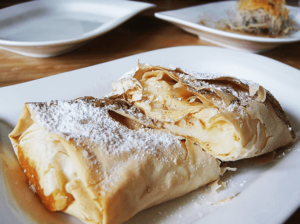
Bougatsa, a breakfast pastry, is very popular. Another common snack is koulouri. Famous sweets include Trigona and Armenonville. The Frappé coffee was invented at the Thessaloniki International Fair in 1957 and is now a symbol of Greek coffee culture.
The Kapani or Agora Viali is the oldest central market in Thessaloniki, selling fresh food and spices.
Tourism in Thessaloniki
Tourism in Thessaloniki has grown a lot, especially from nearby countries. The city is known as "the city that never sleeps" and a "party capital" because of its lively nightlife and young atmosphere.
Education in Thessaloniki
Thessaloniki is a major education center in Greece. Three of the country's largest universities are located here: Aristotle University of Thessaloniki, the University of Macedonia, and the International Hellenic University. Aristotle University, founded in 1926, is the largest university in Greece with over 80,000 students. It is ranked among the top universities worldwide.
The city also has the Alexander Technological Educational Institute of Thessaloniki and many vocational schools. Many private colleges offer American and UK academic programs. Thessaloniki attracts many foreign students. In 2006, the city's total student population was around 200,000.
Getting Around Thessaloniki
Old Tram System
Trams were once the main public transport in Thessaloniki, from 1893 to 1957.
Bus Transport
The Thessaloniki Urban Transport Organization (OASTH) operates buses, which are the only form of public transport in the city. They have over 600 buses on 75 routes. Long-distance buses are available at the Macedonia InterCity Bus Terminal.
Metro System
Plans for a metro system in Thessaloniki go back to 1918. Construction on the current metro began in 2006. It is a very large project with a budget of €1.57 billion. Line 1 and Line 2 are being built and will open in phases between 2023 and 2024.
Many important archaeological discoveries have been made during construction. Some metro stations will have archaeological exhibitions. The Venizelou station will even have the world's first open archaeological site inside a metro station.
Once it opens, the metro is expected to serve 320,000 people every day. There are plans to expand the metro to the western suburbs and to the airport.
Suburban Rail
Commuter train services, called "Proastiakos", connect Thessaloniki to the city of Larissa. The journey takes about 1 hour and 33 minutes. There is also a train line to Edessa.
Thessaloniki Airport "Makedonia"
Thessaloniki Airport "Makedonia" handles international and domestic flights. A major extension is underway to lengthen one of its runways into the Thermaic Gulf. This will allow the airport to handle larger aircraft and intercontinental flights in the future. A second terminal was completed in February 2021.
Railways
Thessaloniki is an important railway hub in Greece. Regional train services connect the city with other parts of the country from its central railway station.
Port of Thessaloniki
The Port of Thessaloniki offers seasonal ferries to the Sporades and other islands. Its passenger terminal is one of the largest in the Aegean Sea. The port is being upgraded and is becoming a major tourist port for cruises in the eastern Mediterranean.
Motorways
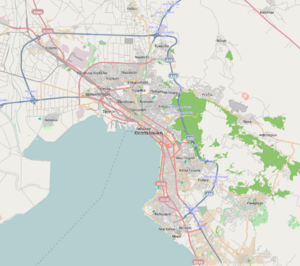
Thessaloniki is located at the meeting point of several major motorways (A1/E75, A2/E90, and A25). These connect the city to other parts of Greece and neighboring countries like North Macedonia, Bulgaria, and Turkey.
The city has an inner ring road that goes around it. This road handles over 120,000 vehicles daily. There are plans to improve this road and build a new elevated motorway section to help with traffic.
Long-term plans include extending an outer ring road to completely bypass the city, possibly with a bridge over the Thermaic Gulf.
International Connections
Consulates
Thessaloniki hosts many consulates from different countries around the world.
Twin Towns and Sister Cities
Thessaloniki is twinned with many cities around the world. This means they have special friendly relationships and often work together on projects. Some of its twin cities include:
- Hartford, United States (1962)
- Alexandria, Egypt (1993)
- Bologna, Italy (1984)
- Leipzig, Germany (1984)
- Limassol, Cyprus (1984)
- Melbourne, Australia (1984)
- Plovdiv, Bulgaria (1984)
- Bratislava, Slovakia (1986)
- Cologne, Germany (1988)
- Constanţa, Romania (1988)
- San Francisco, United States (1990)
- Nice, France (1992)
- Tel Aviv, Israel (1994)
- Kolkata, India (2005)
- Korçë, Albania (2005)
- Busan, South Korea (2010)
- Durrës, Albania (2012)
Other Partnerships
Thessaloniki also cooperates with other cities, including:
- Toronto, Canada (1986)
- Budapest, Hungary (1993)
- Brooklyn (New York), United States (1993)
- Boston, United States (1996)
- Shenyang, China (2000)
- Gyumri, Armenia (2000)
- Philadelphia, United States (2002)
- Saint Petersburg, Russia (2002)
- Dnipro, Ukraine (2003)
- Venice, Italy (2003)
- Dongguan, China (2008)
- Nagoya, Japan (2019)
See also
 In Spanish: Salónica para niños
In Spanish: Salónica para niños




